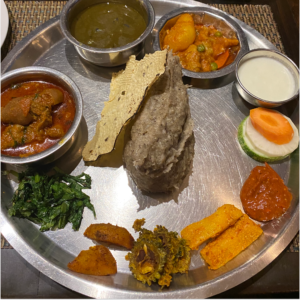11 students from Nepal recommend outstanding Nepali cuisine

Thakali Khana
March 8, 2024
Unique Nepali foods everyone must taste once in their life
Students from the Harbingers’ Kathmandu newsroom were asked to recommend dishes from Nepali cuisine they consider outstanding.
Each of the 11 students wrote about a traditional dish they would like every reader to try once they land themselves at the feet of the Himalayas.
Jefferson He, the OXSFJ Nepal project editor, added his own personal favourite – momos.
Thakali Khana
Thakali khana is a complete meal of different dishes including rice, dal, curry, pickle and local chicken and mutton. It is usually eaten in the winter season as it provides heat and energy. It can be cooked at home in a simple and easy way but is also found in hotels and restaurants.
Recommended by Binita Nepali (aged 14)
Dhindo
Dhindo is a staple of Nepal, it can be included within thakali khana. It is made from flour (any type of flour like maize can be used) and boiled water stirred together, you can also add ghee (melted butter), garlic, salt, and sugar into it. Some restaurants serve ghee separately which is then poured over the dhindo.
Recommended by Suraj Tamang (aged 15)
Chapati
Chapati is an unleavened bread made from flour and oil, and is eaten with tea, milk and pickles. It is also a delicious dish with curry. It is another staple of Nepal and many south Asian countries.
Recommended by Om lal Shrestha (aged 18)
Learn more about the Tihar festival:
Phini Roti
Phini roti is a crispy, multi-layered bread specially made during the festival of Tihar when it is offered to the goddess Laxmi. It is made of four ingredients: all-purpose flour, rice flour, ghee and salt.
This Nepali food item is also made and eaten on special occasions like Dashain, Maghe Sankranti, and weddings.
Recommended by Pratima Chaudhar (aged 13)
Ghonghi
Ghonghi is a type of snail which is eaten during the paddy season which marks when rice is planted in the waters (mid-June to October). In these waters many Ghonghi can be found.
Farmers will collect Ghonghi from the water before cutting off its tail so it is easy for people to suck the snail out of the shell after it is boiled.
Recommended by Santoshi Gurung (aged 14)
Kwati
Kwati is a hot soup made from nine beans, namely bhatmas (soya beans), rajma (red kidney beans), mung (mung beans), bakulla (fava beans), chana (chickpeas), bodi (black-eyed peas), kerau (field peas), mas (black grams) and seto simi (white beans).
Nepali people on the full moon day of Shrawan (a month in Nepal’s official calendar) eat kwati to celebrate Janaipurnima or Gunlaa. Farmers also have kwati to rejuvenate themselves after all the rice plantation is completed for it is packed with many health benefits.
Recommended by Kriti Tamang (aged 15)
Yamari
The Newari people (a Nepali indigenous community) eat yamari (also called yomari) to celebrate a festival marking the end of the rice harvest known as Yomari Punhi. The yamari came from two Nepal Bhasa words, ‘ya’ (to like) and ‘mari’ (traditional bread/delicacy).
It is a steamed dumpling that consists of rice flour on the outside of the dumpling. The inside of the Yomari is filled with sweet things like chaku (concentrated sugarcane juice) and khuwa (dairy food, made from milk).
When people eat the yamari on the fourth day of Yomari Punhi, they see it as a gift from the gods.
Recommended by Samuna B.K (aged 12)
Sel Roti
Sel roti is a traditional ring-shaped fried dough made from rice flour, water, sugar, ghee, and spices. It is eaten during the Hindu festivals of Tihar and Dashain.
Recommended by Rakshya B.K (aged 12)
Gundruk
Gundruk is a fermented leafy vegetable which originated in Nepal. It is made from leafy green vegetables of radish, cauliflower and the roots of radish. It contains a lot of vitamin B which helps our body.
You can make other dishes with gundruk such as gundruk pickles, curry, and many more.
Recommended by Ramaita Chadaxa (aged 13)
Sisnu
Sisnu is a perennial flowering plant, in Nepal Sisnu is mostly used as a dish called sisnu ki jhol (nettle soup). It is made from the young leaves of sisnu.
It is mostly drunk because it has the power to better protect kidney and gallbladder health alongside assisting many conditions such as diabetes.
Recommended by Kalpana B.K. (aged 11)
Khapse
Khapse is a biscuit or pastry that is prepared during Losar (Tibetan New Year). The dough of the khapse is made from flour, eggs, butter, and sugar. Then it is deep fried and sometimes there is sprinkled sugar on top.
Recommended by Laxman B.K. (aged 11)
Momos
Momos are steamed dumplings filled with different types of meat like lamb or pork. It is usually served with a sauce known as achar which is influenced by spices and herbs.
There is also a soup version of momos and they are called jhol momos. The broth is made from achar using a mixture of tomatoes, chillies, cumin, sesame seeds and coriander or mokthuk from boiling pork/buffalo bones.
Recommended by Jefferson He (aged 16)




